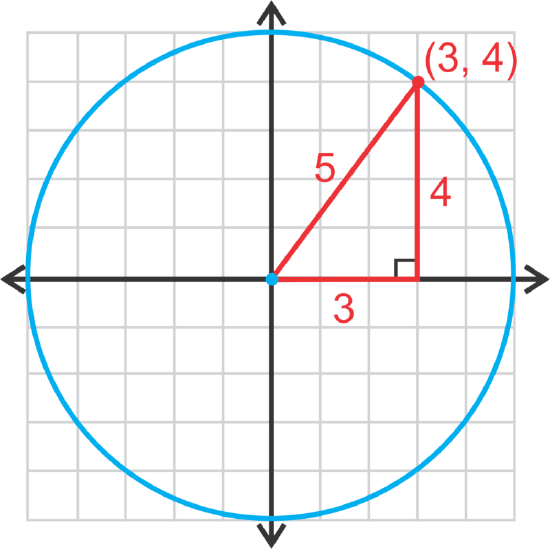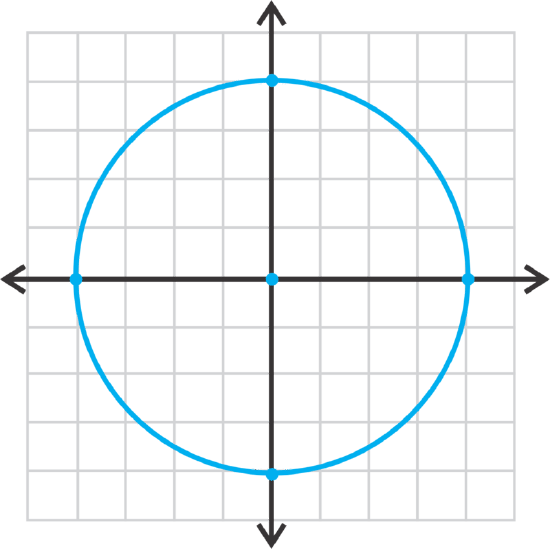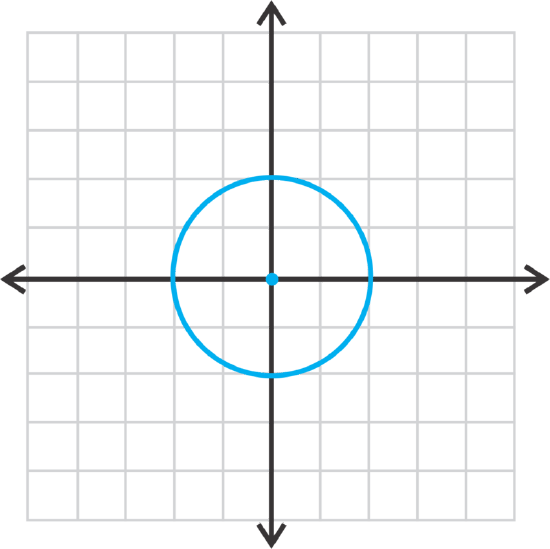Draw a Circle With Origin as Center
half-dozen.4.one: Circles Centered at the Origin
- Page ID
- 14764
Circles Centered at the Origin
You describe a circle that is centered at the origin. You lot measure the bore of the circumvolve to be 32 units. Does the signal \(\ (fourteen,8)\) lie on the circumvolve?
Circles Centered at the Origin
Until now, your but reference to circles was from geometry. A circle is the set of points that are equidistant (the radius ) from a given bespeak (the center ). A line segment that passes through the center and has endpoints on the circle is a bore.
Now, we will take a circumvolve and place it on the x−y plane to encounter if we tin can find its equation. In this concept, we are going to place the center of the circle on the origin.
Finding the Equation of a Circle
Step one: On a piece of graph newspaper, describe an x−y airplane. Using a compass, draw a circle, centered at the origin that has a radius of 5. Detect the point (iii,4) on the circle and describe a correct triangle with the radius as the hypotenuse.

Step 2: Using the length of each side of the right triangle, show that the Pythagorean Theorem is true.
Step three: Now, instead of using (iii, 4), change the point to (x, y) and so that information technology represents any point on the circle. Using r to stand for the radius, rewrite the Pythagorean Theorem.
The equation of a circle, centered at the origin, is \(\ ten^{2}+y^{2}=r^{ii}\), where r is the radius and (10, y) is whatsoever point on the circle.
Let's detect the radius of \(\ x^{ii}+y^{2}=16\) and graph.
To find the radius, we can set \(\ 16=r^{ii}\), making \(\ r=4\). \(\ r\) is not -four because it is a altitude and distances are always positive. To graph the circle, start at the origin and leave iv units in each direction and connect.

Now, let'southward detect the equation of the circle with heart at the origin and passes through \(\ (−7,−7)\).
Using the equation of the circle, nosotros accept: \(\ (-vii)^{2}+(-seven)^{2}=r^{2}\). Solve for \(\ r^{2}\).
\(\ \begin{aligned}
(-7)^{2}+(-7)^{2} &=r^{2} \\
49+49 &=r^{2} \\
98 &=r^{two}
\end{aligned}\)
So, the equation is \(\ x^{2}+y^{2}=98\). The radius of the circle is \(\ r=\sqrt{98}=seven \sqrt{2}\).
Finally, let's determine if the point \(\ (9,−11)\) is on the circle \(\ x^{2}+y^{2}=225\).
Substitute the indicate in for x and y and see if it equals 225.
\(\ \brainstorm{aligned}
9^{2}+(-eleven)^{two} &=225 \\
81+121 & \stackrel{?}{=} 225 \\
202 & \neq 225
\end{aligned}\)
The betoken is non on the circle.
Examples
Earlier, you were asked to determine if the point (14 ,viii) lies on the circumvolve that is centered at the origin and has a bore of 32 units.
Solution
From this lesson, y'all know that the equation of a circle that is centered at the origin is \(\ x^{2}+y^{2}=r^{2}\), where \(\ r\) is the radius and \(\ (x,y)\) is any bespeak on the circumvolve.
With the point \(\ (fourteen,eight)\), \(\ x=14\) and \(\ y=viii\). Nosotros are given the diameter, but we need the radius. Recall that the radius is half the bore, so the radius is \(\ \frac{32}{2}=16\).
Plug these values into the equation of the circle. If they result in a true argument, the point lies on the circle.
\(\ \begin{array}{r}
x^{2}+y^{2}=r^{2} \\
xiv^{2}+8^{2} \stackrel{?}{=} 16^{2} \\
196+64 \stackrel{?}{=} 256 \\
260 \neq 256
\end{array}\)
Therefore the signal does non prevarication on the circle.
Graph and find the radius of \(\ x^{two}+y^{2}=4\).
Solution
\(\ r=\sqrt{four}=2\)

Find the equation of the circle with a radius of \(\ six \sqrt{5}\).
Solution
Plug in \(\ 6 \sqrt{5}\) for \(\ r\) in \(\ x^{two}+y^{ii}=r^{2}\)
\(\ \begin{array}{l}
ten^{ii}+y^{2}=(6 \sqrt{5})^{2} \\
10^{2}+y^{2}=six^{two} \cdot(\sqrt{v})^{ii} \\
x^{two}+y^{two}=36 \cdot 5 \\
ten^{2}+y^{2}=180
\end{array}\)
Find the equation of the circle that passes through (5, viii).
Solution
Plug in (5, eight) for x and y, respectively.
\(\ \brainstorm{aligned}
5^{2}+8^{2} &=r^{ii} \\
25+64 &=r^{2} \\
89 &=r^{2}
\end{aligned}\)
The equation is \(\ x^{2}+y^{two}=89\)
Determine if \(\ (−x, 7)\) is on the circle \(\ x^{2}+y^{two}=149\).
Solution
Plug in \(\ (−x, 7)\) to see if it is a valid equation.
\(\ \begin{aligned}
(-10)^{2}+7^{2} &=149 \\
100+49 &=149
\finish{aligned}\)
Yes, the betoken is on the circumvolve.
Review
Graph the post-obit circles and discover the radius.
- \(\ x^{2}+y^{ii}=nine\)
- \(\ x^{2}+y^{2}=64\)
- \(\ x^{ii}+y^{2}=eight\)
- \(\ x^{ii}+y^{2}=50\)
- \(\ 2 x^{2}+2 y^{2}=162\)
- \(\ 5 x^{2}+5 y^{2}=150\)
Write the equation of the circumvolve with the given radius and centered at the origin.
- \(\ 14\)
- \(\ half-dozen\)
- \(\ 9 \sqrt{2}\)
Write the equation of the circumvolve that passes through the given indicate and is centered at the origin.
- \(\ (7,−24)\)
- \(\ (two,two)\)
- \(\ (−9,−10)\)
Decide if the following points are on the circle, \(\ 10^{2}+y^{two}=74\).
- \(\ (−viii,0)\)
- \(\ (7,−5)\)
- \(\ (half-dozen,−half-dozen)\)
Claiming In Geometry, you learned near tangent lines to a circle. Retrieve that the tangent line touches a circle at one point and is perpendicular to the radius at that signal, called the point of tangency.
- The equation of a circle is \(\ x^{2}+y^{2}=10\) with point of tangency \(\ (−3,1)\).
- Discover the slope of the radius from the center to \(\ (−iii,1)\).
- Notice the perpendicular slope to (a). This is the slope of the tangent line.
- Use the slope from (b) and the given point to find the equation of the tangent line.
- Repeat the steps in #16 to observe the equation of the tangent line to \(\ x^{ii}+y^{2}=34\) with a indicate of tangency of \(\ (3,v)\).
Answers for Review Bug
To run across the Review answers, open this PDF file and look for section ten.three.
Vocabulary
| Term | Definition |
|---|---|
| eye | The center of a circle is the signal that defines the location of the circumvolve. All points on the circle are equidistant from the center of the circle. |
| Circle | A circle is the prepare of all points at a specific distance from a given indicate in two dimensions. |
| Diameter | Bore is the measure out of the altitude across the center of a circle. The diameter is equal to twice the mensurate of the radius. |
| Equation of a Circle | If the center of a circle is (0, 0), then the equation of the circle is of the form \(\ 10^{two}+y^{two}=r^{2}\), where \(\ r\) is the radius. |
| Radius | The radius of a circle is the distance from the center of the circle to the border of the circle. |
Source: https://k12.libretexts.org/Bookshelves/Mathematics/Analysis/6:_Conic_Sections/6.4:_Equations_of_Circles/6.4.1:_Circles_Centered_at_the_Origin
0 Response to "Draw a Circle With Origin as Center"
Post a Comment